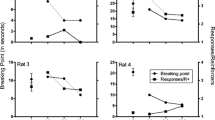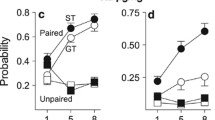Abstract
Two experiments evaluated whether termination of a continuous infusion of naltrexone altered sensitivity to the rate-suppressing or discriminative stimulus effects of morphine in rats. An 8-day infusion of saline or doses of 3, 10, or 18 mg/kg/day naltrexone did not alter rates of lever pressing maintained under fixed-ratio 30 schedules of food delivery. A dose of 10 mg/kg/day naltrexone produced insurmountable antagonism of the rate-suppressing and analgesic effects of morphine. The ED50 of morphine for rate suppression decreased by 2-fold 1 day after termination of the 8-day infusion of 10 or 18 mg/kg/day naltrexone. The ED50 of morphine returned to initial values within 8 days. Termination of infusion of either saline or 3 mg/kg/day naltrexone did not alter the ED50 of morphine. Changes in morphine stimulus control were evaluated in rats trained to discriminate saline and 3.2 mg/kg morphine under fixed-ratio 15 schedules of food delivery. The ED50 of morphine for stimulus control or rate suppression decreased by 2-fold 1 day after termination of an 8-day infusion of 18 mg/kg/day naltrexone. The ED50 of morphine for rate suppression returned to initial values within 3 days; that for stimulus control, within 5 days. Thus, termination of exposure to high doses of naltrexone produced brief changes in sensitivity to the rate-altering and discriminative stimulus effects of morphine that parallel reported changes in sensitivity to the analgesic and lethal effects of morphine.
Similar content being viewed by others
References
Bardo MT, Neisewander JL (1987) Chronic naltrexone supersensitizes the reinforcing and locomotor-activating effects of morphine. Pharmacol Biochem Behav 28:267–273
Bardo MT, Bhatnagar RK, Gebhart GF (1982) Differential effects of chronic morphine and naloxone on opiate receptors, monoamines, and morphine-induced behaviors in preweanling rats. Dev Brain Res 4:139–147
Bardo MT, Bhatnagar RK, Gebhart GF (1983a) Age-related differences in the effects of chronic administration of naloxone on opiate binding in rat brain. Neuropharmacology 22:453–461
Bardo MT, Bhatnagar RK, Gebhart GF (1983b) Chronic naltrexone increases opiate binding in brain and produces supersensitivity to morphine in the locus coeruleus of the rat. Brain Res 289:223–234
Bardo MT, Miller JS, Risner ME (1984) Opiate receptor supersensitivity produced by chronic naloxone treatment: dissociation of morphine-induced antinociception and conditioned taste aversion. Pharmacol Biochem Behav 21:591–597
Bardo MT, Neisewander JL, Ennis RB (1988) Chronic treatment with naltrexone enhances morphine-stimulated dopamine neurotransmission: neurochemical and behavioral evidence. Neuropharmacology 27:1103–1109
Braude MC, Morrison JM (1976) Preclinical toxicity studies of naltrexone. In: Julius D, Renault P (eds) Narcotic antagonists: naltrexone. NIDA Res Monogr 9, DHEW Pub. No. (ADM)77-387, US Government Printing Office, Washington, DC, pp 16–26
Brunello N, Volterra A, Di Giulio AM, Cuomo V, Racagni G (1984) Modulation of opioid system in C57 mice after repeated treatment with morphine and naloxone: biochemical and behavioral correlates. Life Sci 34:1669–1678
Cooper SJ, Turkish S (1989) Effects of naltrexone on food preference and concurrent behavioral responses in food-deprived rats. Pharmacol Biochem Behav 33:17–20
D'Amour FE, Smith DL (1941) A method for determining loss of pain sensation. J Pharmacol Exp Ther 72:74–79
France CP, Morse WH (1989) Pharmacological characterization of supersensitivity to naltrexone in squirrel monkeys. J Pharmacol Exp Ther 250:928–936
Goldberg SR, Morse WH, Goldberg DM (1981) Acute and chronic effects of naltrexone and naloxone on schedule-controlled behavior of squirrel monkeys and pigeons. J Pharmacol Exp Ther 216:500–509
Harris LS, Pierson AK (1964) Some narcotic antagonists in the benzomorphan series. J Pharmacol Exp Ther 143:141–148
Kelleher RT, Goldberg SR (1979) Effects of naloxone on schedule-controlled behavior in monkeys. In: Usdin E, Bunney WE, Kline NS (eds) Endorphins in mental health research. Oxford University Press, New York, pp 461–472
Lahti RA, Collins RJ (1978) Chronic naloxone results in prolonged increases in opiate binding sites in brain. Eur J Pharmacol 51:185–186
Marks-Kanfman R, Balmagiya T, Gross E (1984) Modifications in food intake and energy metabolism in rats as a function of chronic naltrexone infusions. Pharmacol Biochem Behav 20:911–916
Millan MJ, Morris BJ, Herz A (1988) Antagonist-induced opioid receptor up-regulation. I. Characterization of supersensitivity to selective mu and kappa agonists. J Pharmacol Exp Ther 247:721–728
Morris BJ, Millan MJ, Herz A (1988) Antagonist-induced opioid receptor up-regulation. II. Regionally specific modulation of mu, delta and kappa binding sites in rat brain revealed by quantitative autoradiography. J Pharmacol Exp Ther 247:729–736
Pfeiffer A, Pfeiffer DG, Feuerstein G, Faden AI, Kopin IJ (1984) An increase in opiate receptor-sites is associated with enhanced cardiovascular depressant, but not respiratory depressant action of morphine. Brain Res 296:305–311
Sanger DJ, McCarthy PS, Lord JAH, Smith CFC (1983) The anorectic properties of opiate antagonists. Drug Dev Res 3:137–142
Schenk S, Nawiesniak E (1985) Chronic naltrexone treatment increases the heroin-produced facilitation of self-stimulation. Pharmacol Biochem Behav 22:175–177
Schindler CW, Wu X-Z, Su T-P, Goldberg SR, Katz JL (1990) Enhanced sensitivity to behavioral effects of naltrexone in rats. J Pharmacol Exp Ther 252:8–14
Schulz R, Wurster M, Herz A (1979) Supersensitivity to opioids following the chronic blockade of endorphin action by naloxone. Naunyn-Schmiedeberg's Arch Pharmacol 306:93–96
Snell D, Feller D, Bylund D, Harris RA (1982) Sensitization produced by repeated administration of naloxone is blocked by food deprivation. J Pharmacol Exp Ther 221:444–452
Spealman RD, Kelleher RT, Morse WH, Goldberg SR (1981) Supersensitivity to the behavioral effects of opiate antagonists. Psychopharmacol Bull 17:54–56
Tang AH, Collins RJ (1978) Enhanced analgesic effects of morphine after chronic administration of naloxone in the rat. Eur J Pharmacol 47:473–474
Tempel A, Zukin RS, Gardner EL (1982) Supersensitivity of brain opiate receptor subtypes after chronic naltrexone treatment. Life Sci 31:1401–1404
Tempel A, Gardner EL, Zukin RS (1985) Neurochemical and functional correlates of naltrexone-induced opiate receptor upregulation. J Pharmacol Exp Ther 232:439–444
Warren PH, Morse WH (1989) Environmental determinants of enhanced sensitivity to the behavioral effects of naltrexone. J Pharmacol Exp Ther 248:546–551
Yoburn BC, Inturrisi CE (1988) Modification of the response to opioid and nonopioid drugs by chronic opioid antagonist treatment. Life Sci 42:1689–1696
Yoburn BC, Goodman RR, Cohen AH, Pasternak GW, Inturrisi CE (1985) Increased analgesic potency of morphine and increased brain opioid binding sites in the rat following chronic naltrexone treatment. Life Sci 36:2325–2332
Yoburn BC, Cohen AH, Inturrisi CE (1986a) Pharmacokinetics and pharmacodynamics of subcutaneous naltrexone pellets in the rat. J Pharmacol Exp Ther 237:126–130
Yoburn BC, Nunes FA, Adler B, Pasternak GW, Inturrisi CE (1986b) Pharmacodynamic supersensitivity and opioid receptor upregulation in the mouse. J Pharmacol Exp Ther 239:132–135
Young AM, Doty MD (1989) Enhancement of the discriminative and rate-altering effects of morphine following continuous naltrexone exposure. Pharmacologist 31:157
Young AM, Mattox SR (1988) Enhancement of the rate-altering effects of morphine following chronic naltrexone treatment (Abstract). In: Harris LS (ed) Problems of drug Dependence 1988. NIDA Res Monogr 90, DHHS Pub. No. (ADM)89–1605, US Government Printing Office, Washington, DC, p 330
Zukin RS, Sugarman JR, Fitz-Syage ML, Gardner EL, Zukin SR, Gintzler AR (1982) Naltrexone-induced opiate receptor supersensitivity. Brain Res 245:285–292
Author information
Authors and Affiliations
Rights and permissions
About this article
Cite this article
Young, A.M., Mattox, S.R. & Doty, M.D. Increased sensitivity to rate-altering and discriminative stimulus effects of morphine following continuous exposure to naltrexone. Psychopharmacology 103, 67–73 (1991). https://doi.org/10.1007/BF02244076
Received:
Revised:
Issue Date:
DOI: https://doi.org/10.1007/BF02244076




